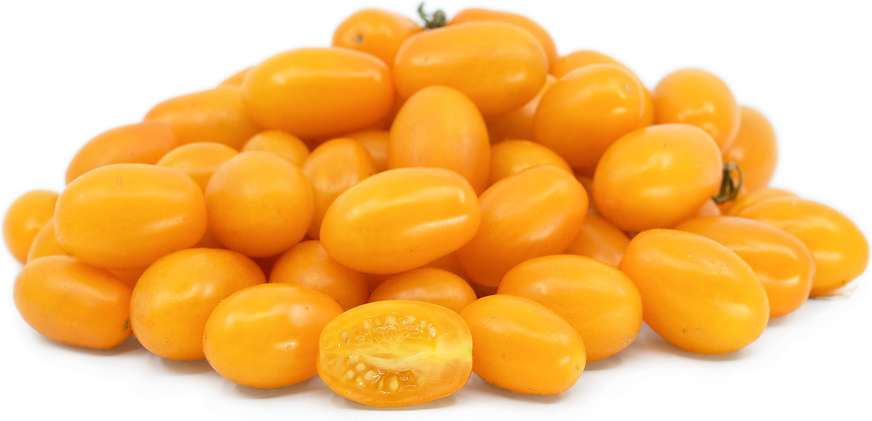


Yellow Datterini Tomatoes
Estimated Inventory, lb : 0
Description/Taste
Yellow Datterini tomatoes are a small-sized varietal, averaging 1 to 3 centimeters in diameter, and have an elongated, oval appearance with curved edges and a slightly pointed tip at one end. The tomato's skin is semi-thin, smooth, taut, and glossy, showcasing vibrant golden yellow-orange hues. Underneath the surface, the flesh is dense, yellow-orange, and aqueous with a crisp, chewy, succulent consistency. The flesh also contains a few tiny and edible seeds that are unnoticeable. Yellow Datterini tomatoes are firm, even when ripe, and release a fragrant aroma when sliced. The tomato's flesh has high sugar content and low acidity, creating a sweet, tangy, and subtly acidic flavor with fruity, savory undertones.
Seasons/Availability
Yellow Datterini tomatoes are available in the summer, typically in season from July through September.
Current Facts
Yellow Datterini tomatoes, botanically classified as Solanum lycopersicum, are an Italian heirloom belonging to the Solanaceae or nightshade family. The small, specialty tomatoes are cultivated throughout Southern Italy and are a type of plum tomato favored for its exceptionally sweet taste and low acidity. The name Datterini is derived from the Italian word "dattero," meaning "date." This moniker was given to the variety in reference to its sweet flavor and oval appearance, similar to the desert palm fruit. Yellow Datterini tomatoes are also known as Datterino Giallo or Yellow Datterino, the singular form of Datterini. There are several other varieties of Datterini tomatoes grown throughout Italy and are found in shades of red, red-orange, and sometimes purple. Yellow Datterini tomatoes grow in hanging clusters of 14 to 16 fruits and mature in approximately one hundred days on a plant that reaches two meters in height. The variety can be grown in greenhouses, open fields, or pots and is favored by tomato enthusiasts for its sweet, rich flavoring. Yellow Datterini tomatoes can be used in fresh or cooked culinary preparations and are a variety traditionally canned in Italy.
Nutritional Value
Yellow Datterini tomatoes are a source of vitamin A to maintain healthy organ functioning and vitamin C to strengthen the immune system, increase collagen production, and reduce inflammation. The tomatoes also provide potassium to balance fluid levels within the body, vitamin K to assist in faster wound healing, and other nutrients, including folate, beta-carotene, phosphorus, calcium, and iron.
Applications
Yellow Datterini tomatoes have a bright, sweet flavoring suited for fresh and cooked preparations. The tomatoes are popularly consumed straight out of hand, or they can be placed on appetizer platters with cheeses and cured meats, tossed into salads, chopped into salsa and dips, and put on top of bruschetta. Yellow Datterini tomatoes are also commonly simmered into sauces, mixed into soup broths, or blended into pastes. The tomato's sweet taste and low acidity complement savory ingredients as a pizza topping, baked into focaccia or incorporated into an array of seafood dishes. They can also be sliced fresh and added to cooked meats and vegetables to provide a bright flavoring. Beyond fresh and cooked recipes, Yellow Datterini tomatoes are typically preserved whole in their juices and canned as a method of extended storage. Canned Yellow Datterini tomatoes are used similarly to fresh tomatoes and are added to sauces, main dishes, and stews. The tomatoes can also be dried and preserved to store throughout the winter. Yellow Datterini tomatoes pair well with pancetta, aromatics such as garlic, shallots, onions, and ginger, seafood including clams, white fish, mussels, squid, shrimp, and scallops, herbs such as parsley, oregano, basil, and thyme, fennel, green beans, and citrus. Whole, unwashed Yellow Datterini tomatoes will keep for 1 to 2 weeks when stored at room temperature until ripe. Once mature, the tomatoes can be kept in the refrigerator for 1 to 2 days to slow the spoiling process.
Ethnic/Cultural Info
Some of the first tomatoes introduced into Italy in the 16th century were yellow varieties, earning tomatoes the nickname "pomo d'oro" or "golden apple" around 1548. Yellow tomatoes were initially valued as a rare ornamental plant, grown in the gardens as a novelty among the upper class in Europe, but over time as tomatoes became a common crop, yellow tomatoes were eventually overshadowed by red tomato varieties. Red tomatoes displayed hardier cultivation qualities throughout the Mediterranean, reserving yellow tomatoes to only being grown in home gardens throughout southern Italy. Southern Italian residents lived off of a primarily plant-based diet, combining tomatoes with vegetables, spices, and other aromatics and serving the mixture with a grain or bread to create a filling meal. This tomato-heavy diet helped protect unusual varieties such as Yellow Datterini tomatoes, and as canning became a traditional method of preservation, the yellow varieties began to reappear in gardens, renowned for their sweet flavors.
Geography/History
Yellow Datterini tomatoes are native to Italy and are descendants of ancient tomato varieties carried from South America to Europe through Spanish explorers in the 16th century. Datterini tomatoes are primarily grown in Southern Italy, specifically Campania and Sicily, and thrive in warm environments with extended sunlight. Throughout history, Yellow Datterini tomatoes have been favored for canning and were a variety preserved in Italy for use during the winter season. Over time, the yellow tomatoes increased in popularity outside of Italy and have recently become favored in commercial markets for their sweet flavoring. Yellow Datterini tomatoes are sold fresh as a specialty variety in select grocers, farmers markets, and distributors throughout Europe. They are also grown in home gardens worldwide. The Yellow Datterini tomatoes featured in the photograph above were sourced from Natoora in London, England.
Recipe Ideas
Recipes that include Yellow Datterini Tomatoes. One
| Solo Dolce |
|
Pasta with Yellow Datterino Tomatoes and Pancetta |




